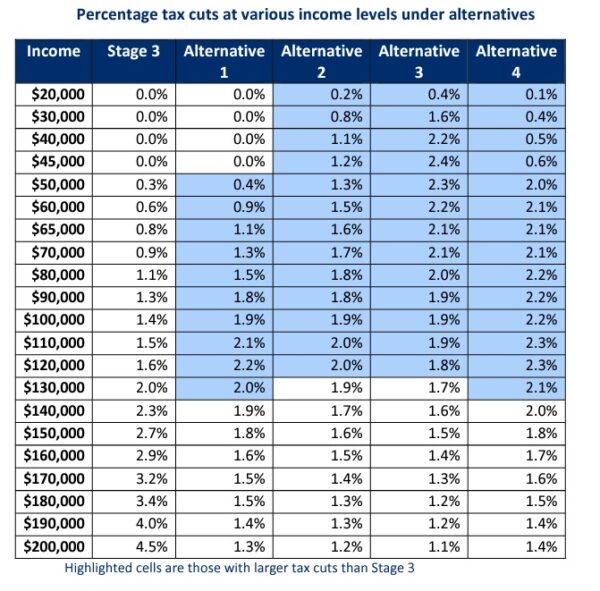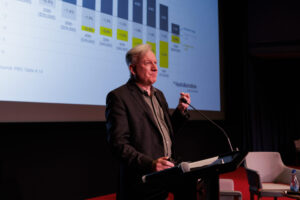Stage 3 Better: A way for the government to deliver better, fairer tax cuts and save money
The Stage 3 tax cuts cost too much, deliver little benefit to those who need it, and leave Australia less fair. We propose 4 ways to make Stage 3 Better

The Stage 3 cuts due to come into effect in July 2024 are the most expensive and most inequitable tax cuts in Australia’s history. If they were listed as expenditure, they would be the ninth most expensive program item in the budget.
The Parliamentary Budget Office’s latest calculations estimate that over the first 10 years after the cuts come into effect, they will mean that the Federal Government will collect $320 billion less tax revenue than it would have done otherwise. In the first year alone, the cuts are estimated to cost $21 billion in foregone revenue. This is $1 billion less than the entire budget surplus for 2022–23, equal to the annual budgeted expenditure for financial support for People with Disability in 2024–25, and some $6 billion more than the amount budgeted for Job Seeker Income Support.
This might be justifiable were the Stage 3 tax cuts good policy that benefits a majority of Australians and set us up for the future.
In reality they deliver more then 70% of the benefit to the richest 20% of tax payers and cost so much that limits the ability for the government to respond to spending challenges due to rising costs and the need to move the economy to net zero.
Scrapping the Stage 3 tax cuts however is politically difficult. But rather than view the Stage 3 cuts as a burden, we argue the Albanese government should see them as an opportunity for them to deliver real tax reform than leave median and average income earner better off and the budget much more able to adapt to the challenges we face.
We propose 4 alternatives:
Alternative one
Reduce the 32.5% rate to 29% for people earning between $45,001 and $120,000
This would give the biggest tax cut to people on $120,000 or less (2.2%)
Everyone earning up to $130,700 would receive a larger tax cut (%) than under the existing Stage 3
Taxpayers would save $130 billion over a decade
Alternative two
Reduce the 19% tax rate for those earning between $18,201 and $45,000 to 17%, and lower the 32.5% tax rate for those earning between $45,001 and $120,000 to 30%
This would give the biggest cut to people on $120,000 or less (2%)
Everyone earning up to $127,600 would receive a larger tax cut (%) than under Stage 3 as it stands
Taxpayers would save $111 billion over a decade
Alternative three
Lower the 19% tax rate for those earning between $18,201 and $45,000 to 15%, and the 32.5% tax rate for those earning between $45,001 and $120,000 to 31%
This would give the biggest tax cut to those earning $45,000 (2.4%)
All taxpayers earning up to $124,600 receive a larger tax cut (%) than would be the case under Stage 3
Taxpayers would save $92 billion over a decade
Alternative four
Lower the 19% tax rate to 18%, raising the $45,000 threshold to $50,000. Cut the 32.5% to 30% tax rate for those earning between $45,001 and $120,000, with the threshold raised to $50,001.
This would give the largest tax cut to those earning $120,000 (2.3%)
Everyone earning up to $132,400 would receive a larger tax cut (%) than would be the case under Stage 3
Taxpayers would save $70 billion over a decade
All four alternatives cost less than Stage 3.
All four alternatives deliver better tax cuts to those most affected by bracket creep and rising inflation.
All four alternatives give the government the ability to deliver tax cuts and improve services, infrastructure, income support.
Stage 3 Better.
Related research
Between the Lines Newsletter
The biggest stories and the best analysis from the team at the Australia Institute, delivered to your inbox every fortnight.
You might also like
Stage 3 Better – Revenue Summit 2023
Presented to the Australia Institute’s Revenue Summit 2023, Greg Jericho’s address, “Stage 3 Better” outlines an exciting opportunity for the government to gain electoral ground and deliver better, fairer tax cuts for more Australians.
18 Reasons why the Stage 3 tax cuts should be redesigned
Australia Institute research shows the Stage 3 income tax cuts are fiscally irresponsible, massively expensive and completely unfair.
18 Reasons why the Stage 3 tax cuts should be redesigned
Australia Institute research shows the Stage 3 income tax cuts are fiscally irresponsible, massively expensive and completely unfair. Here are 18 reasons why they should be redesigned.




